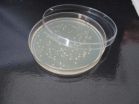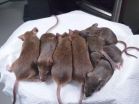Dual systems key to keeping chromosomes intact
Scientists discover that 2 different molecular mechanisms work together to prevent 'genome instability,' which can kill cells or cause cancer
2013-03-07
(Press-News.org) USC scientists have discovered how two different structural apparatuses collaborate to protect repetitive DNA when it is at its most vulnerable – while it is being unzipped for replication.
The centromere—the center of the "X" shape of a chromosome—contains repeated DNA sequences that are epigenetically coded to attract so-called heterochromatin proteins. This protects the structure to ensure that the chromosomes separate properly. If the heterochromatin is lost (due to mutations in the cell), the repetitive DNA becomes vulnerable to rearrangements and recombination. This particularly true during DNA replication, when the DNA is transiently unwound to be copied.
If there are also defects in replication fork proteins that cause this process to be delayed or inefficient, the rearrangements are dramatically increased. This "genome instability" can lead to loss of genetic information or genetic changes that can lead to cell death or cause cancer.
Susan Forsburg, who led the USC team that conducted the research, used yeast cells to show that simultaneously disrupting both heterochromatin and replication fork proteins caused significant increases in abnormal chromosomes, and in some cases, cell death.
"The insight here is really understanding the mechanism of how these different mutants create a lethal collaboration," said Forburg, a professor of molecular biology at the USC Dornsife College of Letters, Arts and Sciences. "Importantly, all the genes we study have human equivalents—and mutations of some of these are already linked to cancer."
The research appears online in Cell Reports on March 7. Forsburg worked with Pao-Chen Li, formerly a graduate student at USC and now a post-doctoral researcher at UCSF; as well as Ruben C. Petreaca, Amanda Jensen, Ji-Ping Yuan and Marc D. Green, all from USC.
"We already knew epigenetic modifications change gene expression in cancer," Forsburg said. "Now we see a synergistic effect between the structural role of epigenetic modification that creates heterocrhomatin, and replication fork stability."
The next step will be to identify additional components that show this same synergistic effect and to determine what other functions act with heterochromatin to preserve genome stability.
INFORMATION:
This research was funded by the National Science Foundation and the National Institutes of Health.
END
ELSE PRESS RELEASES FROM THIS DATE:
2013-03-07
According to his theory, bacteria that are non-resistant to antibiotics acquire said resistance accidentally because they take up the DNA of others that are resistant, due to the stress to which they are subjected.
A University of Granada researcher has formulated a new hypothesis concerning an enigma that the scientific community has still not been able to solve and which could revolutionise the pharmaceutical industry: Why are bacteria becoming increasingly more resistant to antibiotics? His work has revealed that the use of antibiotics can even cause non-resistant bacteria ...
2013-03-07
Delhi, March 7, 2013 - In the first gender benchmarking study of its kind, researchers have found that numbers of women in the science, technology and innovation fields are alarmingly low in the world's leading economies, and are actually on the decline in many, including the United States. India's low overall ranking in the study shows slow progress despite women friendly policies which have been in place for a number of years.
The full gender benchmarking study maps the opportunities and obstacles faced by women in science in Brazil, South Africa, India, the Republic ...
2013-03-07
Cape Town, March 7, 2013 – In the first gender benchmarking study of its kind, researchers have found that numbers of women in the science, technology and innovation fields (STI) are alarmingly low in the world's leading economies, and are actually on the decline in many, including the United States. For South Africa, results show that women have more opportunities available to them than ever before, however, their participation in the science, technology and innovation workforce remains low.
The full gender benchmarking study maps the opportunities and obstacles faced ...
2013-03-07
Using the technique that created Dolly the sheep, researchers from the RIKEN Center for Developmental Biology in Kobe, Japan have identified a way to produce healthy mouse clones that live a normal lifespan and can be sequentially cloned indefinitely.
Their study is published today in the journal Cell Stem Cell.
In an experiment that started in 2005, the team led by Dr. Teruhiko Wakayama has used a technique called somatic cell nuclear transfer (SNCT) to produce 581 clones of one original 'donor' mouse, through 25 consecutive rounds of cloning.
SNCT is a widely ...
2013-03-07
SAN FRANCISCO (March 7, 2013) —A nationwide study of women in Denmark who are of child-bearing age finds that those who are obese appear to have a much greater risk of heart attack or stroke, according to research being presented at the American College of Cardiology's 62nd Annual Scientific Session.
In fact, women with a high body mass index (BMI)—a measure of the body's fat content—that is indicative of obesity were twice as likely as those of normal weight to suffer a potentially life-threatening heart attack or stroke within just four to five years following childbirth. ...
2013-03-07
The search for a less-expensive, sustainable source of biomass, or plant material, for producing gasoline, diesel and jet fuel has led scientists to duckweed, that fast-growing floating plant that turns ponds and lakes green. That's the topic of a report in ACS' journal Industrial & Engineering Chemistry Research.
Christodoulos A. Floudas, Xin Xiao and colleagues explain that duckweed, an aquatic plant that floats on or near the surface of still or slow-moving freshwater, is ideal as a raw material for biofuel production. It grows fast, thrives in wastewater that has ...
2013-03-07
In a step toward understanding and exploiting an exotic form of matter that has been sparking excitement for potential applications in a new genre of supercomputers, scientists are reporting the first identification of a naturally occurring "topological insulator" (TI). Their report on discovery of the material, retrieved from an abandoned gold mine in the Czech Republic, appears in the ACS journal Nano Letters.
Pascal Gehring and colleagues point out that synthetic TIs, discovered only a decade ago, are regarded as a new horizon in materials science. Unlike conventional ...
2013-03-07
WASHINGTON and NEW YORK—A report released today by the George Washington University School of Public Health and Health Services (SPHHS) and the RCHN Community Health Foundation offers the first-ever in-depth examination of health centers' role in access to family planning. The report finds that virtually all health centers furnish family planning services to some extent but for both financial and non-financial reasons, only 1 in 5 is able to offer access to the full range of contraceptive services.
The report offers a series of recommendations to strengthen performance, ...
2013-03-07
WASHINGTON – Older adults who haven't been in school for a while are as capable of learning from tests as younger adults and college students, according to new research published by the American Psychological Association.
No matter their age or if they work or go to college full time, people appear to learn more when tested on material, rather than simply rereading or restudying information, according to research published online in the APA journal Psychology and Aging.
"The use of testing as a way to learn new information has been thoroughly examined in young students. ...
2013-03-07
São Paolo, March 7, 2013 – In the first gender benchmarking study of its kind, researchers have found that numbers of women in the science, technology and innovation fields are alarmingly low in the world's leading economies, and are actually on the decline in many, including the United States. Results from Brazil show that despite women having a strong representation in parts of the science, technology and innovation sector, and a slight increase in engineering, physics and computer science, overall numbers are on the decline.
Brazil ranks the highest in this study ...
LAST 30 PRESS RELEASES:
[Press-News.org] Dual systems key to keeping chromosomes intact
Scientists discover that 2 different molecular mechanisms work together to prevent 'genome instability,' which can kill cells or cause cancer

